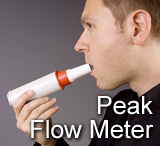A peak flow meter is a portable device that helps people manage their asthma.
A peak flow meter helps to measure the degree of asthma severity and can detect the early stages of asthma before symptoms, such as wheezing or shortness of breath.
The peak flow meter measures the flow of air OUT of the lungs. This is also called the peak expiratory flow rate or "PEFR".
Every person has a baseline measurement that represents their normal lung function. A lower number means that the airways are becoming constricted and reducing the flow of air out of the lungs.
Results of peak flow meter tests can be recorded in an asthma diary to monitor changes over time.
A peak flow meter can be used to:
- Detect early signs of an asthma attack. Decreases of a person’s peak flow can occur BEFORE other asthma symptoms. This helps to inform someone with asthma to increase their use of asthma medication.
- Determine if a rescue medication, such as albuterol, taken during an asthma attack, is helping to open the airways.
- Monitor how well asthma is being controlled in the long run and determine if treatment needs to be adjusted.
How do I use a peak flow meter?
- Always stand up. Remove any food or gum from your mouth.
- Make sure the marker on the peak flow meter is at the bottom of the scale.
- Breathe in slowly and deeply. Hold that breath.
- Place mouthpiece on your tongue and close lips around it to form a tight seal (do not put tongue in the hole).
- Blow out as hard and fast as possible.
- Write down the number next to the marker. (If you cough or make a mistake, do not write down that number. Do it over again.)
- Repeat steps 3 through 6 two more times.
- Record the highest of these three numbers in a notebook, calendar, or asthma diary. Compare the highest number with the peak flow numbers on your written asthma action plan. Check to see which zone the number falls under and follow the plan’s instructions for that zone.
How do I find my Personal Best or Usual Peak Flow?
To use a peak flow meter, you need to first establish your “personal best”: the highest flow rate (PEFR) that you can blow when your lungs are working normally.
Your personal best gives you something to measure against as your asthma symptoms improve or worsen.
- Follow the steps above to take your peak flow daily for 2 to 3 weeks when your asthma is under good control. Record the highest number each day.
- Take peak flow at the same time every day. Peak flows are lowest in the early morning and highest between noon and 5 p.m. Recording peak flows at the same time daily will give you the most consistent numbers.
- The highest number during this period of time will be your personal best number.
- Your doctor or other health care professional may also want you to take your peak flow before and after using your quick-relief medicine. Follow his or her instructions.
- Find a new personal best with each new peak flow meter (different meters can give different numbers).
- Find a new personal best for children every 6 months to allow for growth changes.
Treatment Zones
Once you know your personal best, you and your doctor can develop a treatment plan to respond to different peak flow meter results.
To make a treatment plan easy to remember, it may be organized into “treatment zones” or “traffic lights”.
- GREEN zone: PEFR = 80% to 100% of your personal best. This is considered normal.
- YELLOW zone: PEFR = 50% to 80% of your personal best. This is an important sign of worsening asthma. Contact your doctor to adjust your asthma medication.
- RED zone: PEFR is below 50% of your personal best. This is a sign that your present asthma medications are not providing sufficient control. Your doctor may recommend that you use an inhaled bronchodilator (rescue medication) if you find that you are in this zone. Contact your doctor if your peak flow readings do not return to yellow or green zone after taking the rescue medication.
REMEMBER: Your peak flow meter is only one useful measure and its results may not always be accurate. Do not rely on your peak flow numbers alone when deciding whether to take your rescue medicine or call your doctor.
You should always look out for early warning signs of an asthma attack, including coughing, wheezing, and shortness of breath.
Source: Vivacare
Last updated : 1/8/2019